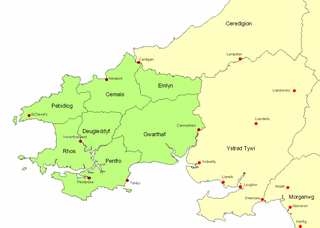Related Research Articles

Llywelyn ap Gruffudd, sometimes written as Llywelyn ap Gruffydd, also known as Llywelyn the Last, was Prince of Wales from 1258 until his death at Cilmeri in 1282. The son of Gruffydd ap Llywelyn Fawr and grandson of Llywelyn the Great, he was the last sovereign prince of Wales before its conquest by Edward I of England.
Gruffydd ap Llywelyn was King of Wales from 1055 to 1063. He had previously been King of Gwynedd and Powys in 1039. He was the son of King Llywelyn ap Seisyll and Angharad daughter of Maredudd ab Owain, and the great-great-grandson of Hywel Dda.

Rhodri ap Merfyn, later known as Rhodri the Great, succeeded his father, Merfyn Frych, as King of Gwynedd in 844. Rhodri annexed Powys c. 856 and Seisyllwg c. 871. He is called "King of the Britons" by the Annals of Ulster. In some later histories, he is referred to as "King of Wales", although the title is anachronistic and his realm did not include southern Wales.

Deheubarth was a regional name for the realms of south Wales, particularly as opposed to Gwynedd. It is now used as a shorthand for the various realms united under the House of Dinefwr, but that Deheubarth itself was not considered a proper kingdom on the model of Gwynedd, Powys, or Dyfed is shown by its rendering in Latin as dextralis pars or as Britonnes dexterales and not as a named land. In the oldest British writers, Deheubarth was used for all of modern Wales to distinguish it from Hen Ogledd, the northern lands whence Cunedda and the Cymry originated.

Cyfraith Hywel, also known as Welsh law, was the system of law practised in medieval Wales before its final conquest by England. Subsequently, the Welsh law's criminal codes were superseded by the Statute of Rhuddlan in AD 1284 and its civil codes by Henry VIII's series of Laws in Wales Acts between 1535 and 1542.
Bleddyn ap Cynfyn, sometimes spelled Blethyn, was an 11th-century Welsh king. Harold Godwinson and Tostig Godwinson installed him and his brother, Rhiwallon, as the co-rulers of Gwynedd on his father's death in 1063, during their destruction of the kingdom of Bleddyn's half-brother, Gruffydd ap Llywelyn. He became king of Powys and co-ruler of the Kingdom of Powys with his brother Rhiwallon from 1063 to 1075. His descendants continued to rule Powys as the House of Mathrafal.
Llywelyn ap Seisyll was an 11th-century King of Gwynedd, Powys and Deheubarth.

Maredudd ab Owain was a 10th-century king in Wales of the High Middle Ages. A member of the House of Dinefwr, his patrimony was the kingdom of Deheubarth comprising the southern realms of Dyfed, Ceredigion, and Brycheiniog. Upon the death of his father King Owain around AD 988, he also inherited the kingdoms of Gwynedd and Powys, which he had conquered for his father. He was counted among the Kings of the Britons by the Chronicle of the Princes.

Brycheiniog was an independent kingdom in South Wales in the Early Middle Ages. It often acted as a buffer state between England to the east and the south Welsh kingdom of Deheubarth to the west. It was conquered and pacified by the Normans between 1088 and 1095, though it remained Welsh in character. It was transformed into the Lordship of Brecknock and later formed the southern and larger part of the historic county of Brecknockshire. To its south was the Kingdom of Morgannwg.
Rhain ap Cadwgan was an 8th-century king of Dyfed and Brycheiniog in Wales of the Early Middle Ages. He succeeded his father Cadwgan, who succeeded his father Caten ap Cloten.

The Kingdom of Dyfed, one of several Welsh petty kingdoms that emerged in 5th-century sub-Roman Britain in southwest Wales, was based on the former territory of the Demetae. The Normans invaded Wales, and by 1138 incorporated Dyfed into a new shire called Pembrokeshire after the Norman castle built in the Cantref of Penfro and under the rule of the Marcher Earl of Pembroke.
Ystrad Tywi is a region of southwest Wales situated on both banks of the River Tywi. Although Ystrad Tywi was never a kingdom itself, it was historically a valuable territory and was fought over by the various kings of Dyfed, Deheubarth, Seisyllwg, Gwynedd, Morgannwg and the Normans.

Creuddyn was a medieval commote and, later, a lordship in Ceredigion, Wales. It was located between the rivers Ystwyth and Rheidol, and was one of the three commotes of Cantref Penweddig. The name, of Old Welsh origin, probably refers to the Pen Dinas hill fort, anciently known as Dinas Maelor. The natural centre of the commote was Llanfihangel y Creuddyn where five roads meet at the village. The name survives in the name of a rural community and church of the same name; however the modern community is much smaller than the medieval commote.
Triffyn son of Rhain was an 8th- and 9th-century king of Dyfed.
Owain son of Maredudd was a king of Dyfed who ruled briefly at the beginning of the 9th century between his brother Rhain and his nephew Triffyn. His death was noted by the undated Annals of Wales. Phillimore's reconstruction places the entry at AD 810.
Rhain son of Maredudd was a king of Dyfed. He ruled following his father Maredudd ap Tewdws and was succeeded by his brother Owain. His son Triffyn then succeeded Owain.
Nobis or Novis is traditionally considered to have been a bishop of Meneva in the medieval Welsh kingdom of Dyfed.
Tudwal Gloff was the youngest of the four sons of Rhodri the Great.
Dafydd Llywelyn is a Welsh Plaid Cymru politician. Since May 2016, he has served as the Dyfed-Powys Police and Crime Commissioner.
References
- ↑ Charles-Edwards, p. 556.
- ↑ Charles-Edwards, T. Wales and the Britons, 350–1064 , Vol. 1. Oxford Univ. Press, 2012. Accessed 12 Feb 2013.